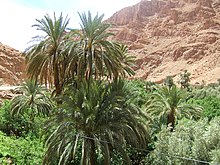תמר
Jump to navigation
Jump to search
Aramaic[edit]
Verb[edit]
תמר • (transliteration needed)
Hebrew[edit]

| Root |
|---|
| ת־מ־ר (t-m-r) |
Etymology[edit]
An early borrowing from Aramaic תמרא (the vocalization of which varies by lect), even Arabic تَمْر (tamr, “date”) is borrowed from it; cognate to Arabic ثَمَر (ṯamar, “fruit”).
Pronunciation[edit]
(file)
Noun[edit]
תָּמָר • (tamár) m (plural indefinite תְּמָרִים) [pattern: קָטָל]
- date (fruit of the date palm)
- date palm, palm tree in general
- Tanach, Exodus 15:27, with translation of the Jewish Publication Society:
- וַיָּבֹ֣אוּ אֵילִ֔מָה וְשָׁ֗ם שְׁתֵּ֥ים עֶשְׂרֵ֛ה עֵינֹ֥ת מַ֖יִם וְשִׁבְעִ֣ים תְּמָרִ֑ים וַיַּחֲנוּ־שָׁ֖ם עַל־הַמָּֽיִם׃
- Va-yavó'u Elíma v-sham shtéim esréi enót máyim v-shiv'ím t'marím va-yaḥanu sham al ha-máyim.
- And they came to Elim, where were twelve springs of water, and three score and ten palm-trees; and they encamped there by the waters.
- Tanach, Deuteronomy 34:3, with translation of the Jewish Publication Society:
- וְאֶת־הַנֶּ֗גֶב וְֽאֶת־הַכִּכָּ֞ר בִּקְעַ֧ת יְרֵח֛וֹ עִ֥יר הַתְּמָרִ֖ים עַד־צֹֽעַר׃
- V'et ha-négev v-et ha-kikár biq'át Y'reiḥó ir ha-t'marím 'ad Tsó'ar.
- the Negeb; and the Plain—the Valley of Jericho, the city of palm trees—as far as Zoar.
Synonyms[edit]
- דֶּקֶל (déqel)
Proper noun[edit]
תָּמָר • (tamár) f
- a female given name, Tamar
Derived terms[edit]
- אַמְנוֹן וְתָמָר (amnón vetamár)
References[edit]
- Barton, George Aaron (1902) A sketch of Semitic origins, social and religious[1], New York and London: The Macmillan Company, page 76
- Guidi, Ignazio (1879) Della sede primitiva dei popoli semitici (in Italian), Rome: Tipi del Salviucci, pages 21–22
- Kogan, Leonid (2011) “Proto-Semitic Lexicon”, in Weninger, Stefan, editor, The Semitic Languages. An International Handbook (Handbücher zur Sprach- und Kommunikationswissenschaft – Handbooks of Linguistics and Communication Science; 36), Berlin: De Gruyter, →ISBN, page 204
- Löw, Immanuel (1924) Die Flora der Juden[2] (in German), volume 2, Wien und Leipzig: R. Löwit, page 316
- Löw, Immanuel (1924) Die Flora der Juden[3] (in German), volume 2, Wien und Leipzig: R. Löwit, page 528
- Nöldeke, Theodor (1875) Mandäische Grammatik[4] (in German), Halle: Verlag der Buchhandlung des Waisenhauses, page 107
Categories:
- Aramaic lemmas
- Aramaic verbs
- Hebrew terms belonging to the root ת־מ־ר
- Hebrew terms borrowed from Aramaic
- Hebrew terms derived from Aramaic
- Hebrew terms with audio links
- Hebrew lemmas
- Hebrew nouns
- Hebrew terms in the pattern קָטָל
- Hebrew masculine nouns
- Hebrew terms with quotations
- Hebrew proper nouns
- Hebrew feminine nouns
- Hebrew given names
- Hebrew female given names
- he:Fruits
- he:Trees